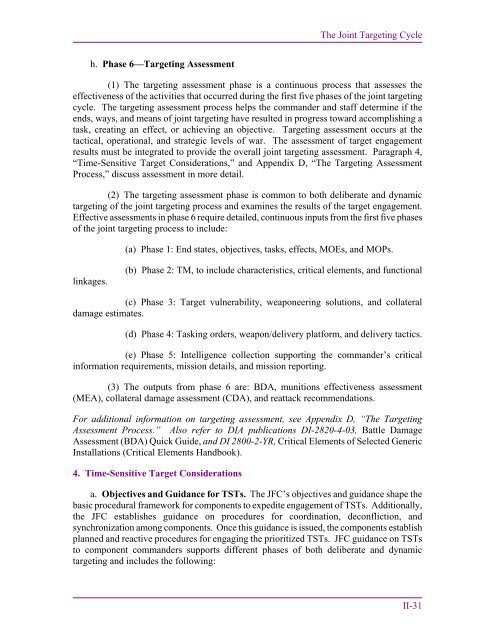Joint Targeting
1F87id9
1F87id9
Create successful ePaper yourself
Turn your PDF publications into a flip-book with our unique Google optimized e-Paper software.
The <strong>Joint</strong> <strong>Targeting</strong> Cycle<br />
h. Phase 6—<strong>Targeting</strong> Assessment<br />
(1) The targeting assessment phase is a continuous process that assesses the<br />
effectiveness of the activities that occurred during the first five phases of the joint targeting<br />
cycle. The targeting assessment process helps the commander and staff determine if the<br />
ends, ways, and means of joint targeting have resulted in progress toward accomplishing a<br />
task, creating an effect, or achieving an objective. <strong>Targeting</strong> assessment occurs at the<br />
tactical, operational, and strategic levels of war. The assessment of target engagement<br />
results must be integrated to provide the overall joint targeting assessment. Paragraph 4,<br />
“Time-Sensitive Target Considerations,” and Appendix D, “The <strong>Targeting</strong> Assessment<br />
Process,” discuss assessment in more detail.<br />
(2) The targeting assessment phase is common to both deliberate and dynamic<br />
targeting of the joint targeting process and examines the results of the target engagement.<br />
Effective assessments in phase 6 require detailed, continuous inputs from the first five phases<br />
of the joint targeting process to include:<br />
(a) Phase 1: End states, objectives, tasks, effects, MOEs, and MOPs.<br />
linkages.<br />
(b) Phase 2: TM, to include characteristics, critical elements, and functional<br />
(c) Phase 3: Target vulnerability, weaponeering solutions, and collateral<br />
damage estimates.<br />
(d) Phase 4: Tasking orders, weapon/delivery platform, and delivery tactics.<br />
(e) Phase 5: Intelligence collection supporting the commander’s critical<br />
information requirements, mission details, and mission reporting.<br />
(3) The outputs from phase 6 are: BDA, munitions effectiveness assessment<br />
(MEA), collateral damage assessment (CDA), and reattack recommendations.<br />
For additional information on targeting assessment, see Appendix D, “The <strong>Targeting</strong><br />
Assessment Process.” Also refer to DIA publications DI-2820-4-03, Battle Damage<br />
Assessment (BDA) Quick Guide, and DI 2800-2-YR, Critical Elements of Selected Generic<br />
Installations (Critical Elements Handbook).<br />
4. Time-Sensitive Target Considerations<br />
a. Objectives and Guidance for TSTs. The JFC’s objectives and guidance shape the<br />
basic procedural framework for components to expedite engagement of TSTs. Additionally,<br />
the JFC establishes guidance on procedures for coordination, deconfliction, and<br />
synchronization among components. Once this guidance is issued, the components establish<br />
planned and reactive procedures for engaging the prioritized TSTs. JFC guidance on TSTs<br />
to component commanders supports different phases of both deliberate and dynamic<br />
targeting and includes the following:<br />
II-31


